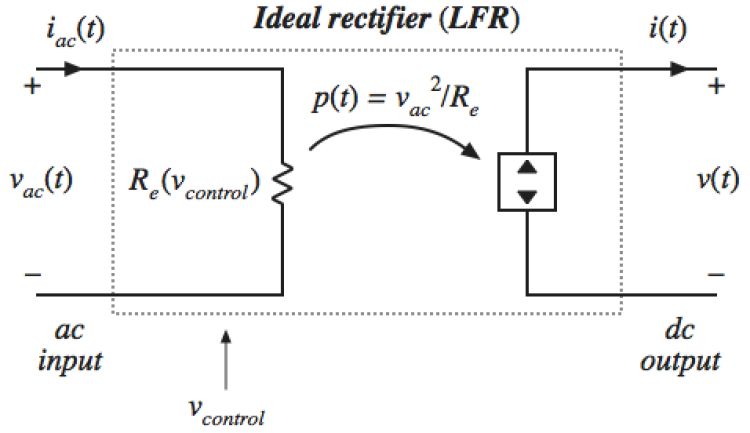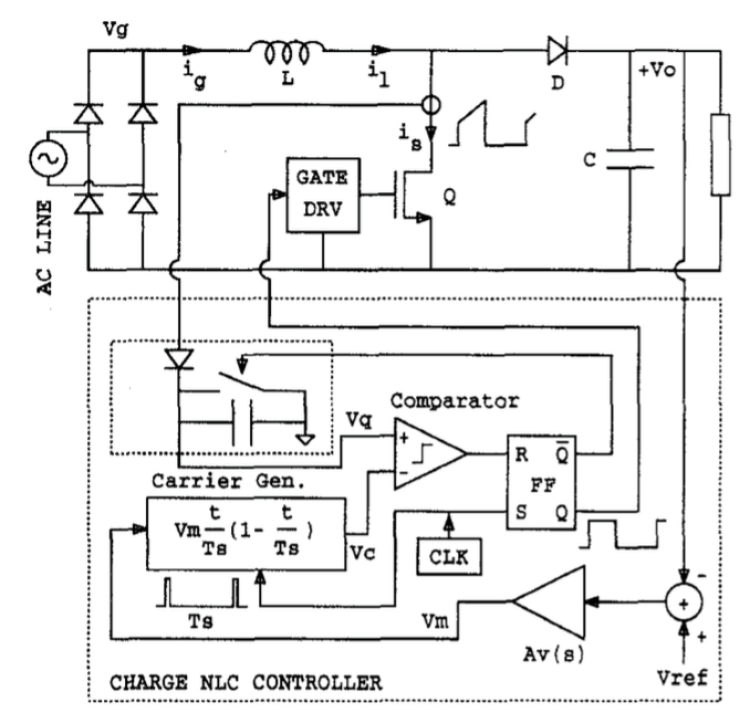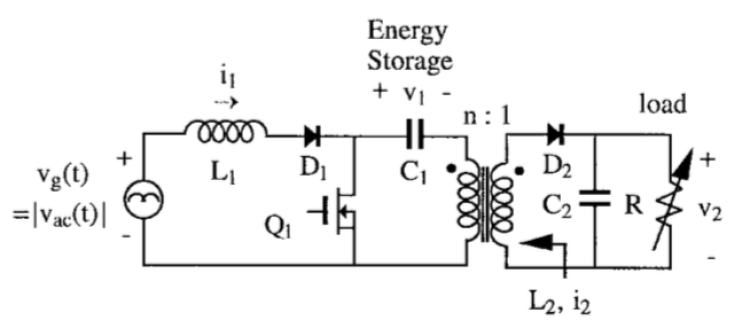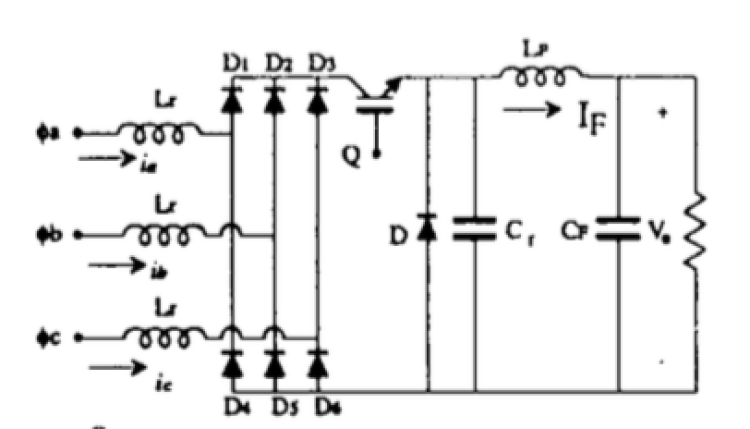Rectifiers
High-quality rectification has been an important research topic of the last several decade, and research in the area continues at many institutions around the world. In these systems, a power converter draws sinusoidal or near-sinusoidal current waveforms from the ac utility system, so that the converter input appears resistive to the utility. Goals of research in this area include: reduction of size and cost of single-phase and three-phase high-quality rectifier systems, control of the ac line current waveforms while also stabilizing the voltage of an energy storage capacitor and regulation of the dc output voltage, and improvement of efficiency, particularly for universal-input systems that operate anywhere in the world.
Low-harmonic rectifiers: modeling and control
- Robert Erickson, Michael Madigan, and Sigmund Singer, “Design of a Simple High Power Factor Rectifier Based on the Flyback Converter,” IEEE Applied Power Electronics Conference, 1990 Record, pp. 792-801, March 1990.

Power-conservative network representing the functions of the ideal rectifier.
The model of the ideal rectifier as an effective resistance plus dependent power source. Equations and waveforms of ideal rectifier systems. A DCM flyback converter as a simple near-ideal rectifier, and its design. See also: related papers on modeling of power-conservative networks. - Jiatian Hong, Esam Ismail, Robert Erickson, and Iftikhar Khan, “Design of the Parallel Resonant Converter as a Low Harmonic Rectifier,” IEEE Applied Power Electronics Conference, 1993 Record, March 1993.
- J. Hong, D. Maksimović, R.W. Erickson, and I. Khan, “Half-Cycle Control of the Parallel Resonant Converter Operated as a High Power Factor Rectifier”, IEEE Transactions on Power Electronics, vol. 10, no. 1, pp. 1-8, January 1995.
- Jiatian Hong, Dragan Maksimovic, Robert Erickson, and Iftikhar Khan, “Half-Cycle Control of the Parallel Resonant Converter Operated as a High Power Factor Rectifier,” IEEE Applied Power Electronics Conference, 1994 Record, March 1994.
- D. Maksimović, Y. Jang, and R. Erickson, “Nonlinear-Carrier Control for High Power Factor Boost Rectifiers,” IEEE Transactions on Power Electronics, Vol. 11, No. 4, July 1996, pp. 578-584.

CCM boost rectifier with nonlinear carrier control.
A controller that transforms a CCM DC-DC converter into a low-harmonic rectifier without sensing the input voltage. This paper received the transactions prize paper award for 1996. - D. Maksimović, Y. Jang, and R. Erickson, “Nonlinear-Carrier Control for High Power Factor Boost Rectifiers,” IEEE Applied Power Electronics Conference, 1995 Record, pp. 635-641.
- D. Maksimović and R. Erickson, “Universal-Input High-Power-Factor Boost Doubler Rectifiers,” IEEE Applied Power Electronics Conference, 1995 Record, pp. 459-465.
Integration of a switch into a boost rectifier system to achieve very high efficiency and low magnetics size in a universal input application. This approach benefits greatly from nonlinear carrier control. - J. Chen, D. Maksimović, and R. Erickson, "A New Low-Stress Buck-Boost Converter for Universal-Input PFC Applications," IEEE Applied Power Electronics Conference, February 2001.
- J. Chen, D. Maksimović, and R. Erickson, "Buck-Boost PWM Converters Having Two Independently Controlled Switches," IEEE Power Electronics Specialists Conference, June 2001.
A systematic converter synthesis approach was employed to derive a complete class of converters containing two independently-controlled switches and capable of single-phase low-harmonic rectification in which the dc output voltage is less than the peak ac input voltage. Several of these exhibit very low inductor size and low loss. - Praneet Athalye, Dragan Maksimovic, and Robert Erickson, “High-Performance Front-End Converter for Avionics Applications,” Proc. PCIM, 2001.

Active-clamp SEPIC IHQRR
An active-clamped SEPIC with internal energy storage, as a low-harmonic rectifier for 400 Hz systems. - A. Prodic, D. Maksimovic, and R. Erickson, “Digitally Controlled Low-Harmonic Rectifier Having Fast Dynamic Responses,” IEEE Applied Power Electronics Conference, March 2002.
- A. Prodic, J. Chen, D. Maksimović, and R. Erickson, “Self-Tuning Digitally Controlled Low-Harmonic Rectifier Having Fast Dynamic Response,” IEEE Transactions on Power Electronics, special issue on digital control in power electronics circuits and drives, pp. 420-428, January 2003.
- P. Athalye, D. Maksimović, R. Erickson, “DSP implementation of a single-cycle predictive current controller in a boost PFC rectifier,” IEEE Applied Power Electronics Conference and Exposition 2005, vol. 2, pp. 837-842, March 6-10, 2005.
- A. Prodic, D. Maksimović, R. W. Erickson, “Dead-zone digital controllers for improved dynamic response of low harmonic rectifiers,” IEEE Transactions on Power Electronics, vol. 21, no. 1, pp. 173-182, January 2006.
Integrated high-quality rectifier-regulators
These papers investigate the integration of the functions of single-phase high-quality rectification, internal low-frequency energy storage, and fast output voltage regulation into a single converter circuit containing a single controllable switch. An early paper showed how this is possible, and introduced several basic topologies. Many other authors later published in this area. This approach can be attractive if the range of operating points is small, but otherwise component stresses can become large and efficiency can suffer. Some later research (in sections above) investigated the opposite approach: introduce additional switches to highly optimize efficiency over a wide range of operating points.
- Michael Madigan, Robert Erickson, and Esam Ismail, “Integrated High Quality Rectifier-Regulators,” IEEE Power Electronics Specialists Conference, 1992 Record, pp. 1043-1051, June 1992.

The BIFRED IHQRR performs the functions of high-quality rectification, low-frequency energy storage, and output voltage regulation, with a single controllable switch.
This was an early paper that demonstrated the possibility of integrating the high-quality rectification function, energy storage function, and output voltage regulation function into a single-switch converter. The BIFRED and BIBRED topologies were introduced. - M. Madigan, R. Erickson, and E. Ismail, “Integrated High-Quality Rectifier-Regulators,” IEEE Transactions on Industrial Electronics, vol. 46, no. 4, pp. 749-758, August 1999.
- M.A. Johnston and R.W. Erickson, “Reduction of Voltage Stress in the Full Bridge BIBRED by Duty Ratio and Phase Shift Control,” IEEE Applied Power Electronics Conference, 1994 Record, March 1994.
- R. W. Erickson, “Some Topologies of High Quality Rectifiers,” IEEE Conference on Energy, Power, and Motion Control, May 5-6 1997, Tel-Aviv Israel, invited keynote paper.
- L. Petersen and R. Erickson, “Reduction of Voltage Stresses in Buck-Boost Type Power Factor Correctors Operating in Boundary Conduction Mode,” IEEE Applied Power Electronics Conference, February 2003.
Three-phase low-harmonic rectifiers
These papers explore the use of resonant converter circuits to provide natural low-harmonic rectification of a three-phase input using a single active switch.
- Esam Ismail and Robert W. Erickson, “A Single Transistor Three Phase Resonant Switch for High Quality Rectification,” IEEE Power Electronics Specialists Conference, 1992 Record, pp. 1341-1351, June 1992.

Single-switch quasi-resonant three-phase low harmonic buck rectifier.
This early paper demonstrated how a resonant-switch buck converter could be transformed into a three-phase low-harmonic rectifier containing a single active switch. The natural response of the resonant switch network provides natural approximate resistive input characteristics to the three phases, with control of the switch leading to control of the dc output voltage. - Esam Ismail and Robert Erickson, “A New Class of Low Cost Three-Phase High Quality Recitifiers with Zero Voltage Switching,” IEEE Applied Power Electronics Conference, 1993 Record, March 1993.
- Y. Jang and Robert W. Erickson, “New Single-Switch Three-Phase High Power Factor Rectifiers Using Multi-Resonant Zero Current Switching,” IEEE Applied Power Electronics Conference, 1994 Record, pp. 711-717, March 1994.
- E. Ismail, C. Oliveira, and R. Erickson, “A Low Distortion Three-Phase Multi-Resonant Boost Rectifier with Zero Current Switching,” IEEE Applied Power Electronics Conference, 1995 Record, March 1995, pp. 849-855.
- E. Ismail and R. Erickson, “Application of One-Cycle Control to Three-Phase High Quality Resonant Rectifier,” IEEE Power Electronics Specialists Conference, 1995 Record, June 1995.
- E. Ismail and R. Erickson, “Single-Switch 3ø PWM Low Harmonic Rectifiers,” IEEE Transactions on Power Electronics, Vol. 11, No. 2, March 1996, pp. 338-346.
- Y. Jang and R. Erickson, “Design and Experimental Results of a 6kW Single-Switch Three-Phase High Power Factor Rectifier Using Multi-Resonant Zero Current Switching,” IEEE Applied Power Electronics Conference, 1996 Record, pp. 524-530.
This paper demonstrated a single-switch ZVS multiresonant three-phase rectifier using an IGBT. A more complete explanation and documentation of research in this area is contained in the PhD thesis of Yungtaek Jang. - Esam Ismail and Robert Erickson, “A New Class of Low Cost Three-Phase High Quality Recitifiers with Zero Voltage Switching,” IEEE Transactions on Power Electronics, vol. 12, no. 4, pp. 734-742, July 1997.
- E. Ismail, C. Oliveira, and R. Erickson, “A Low-Distortion Three-Phase Multiresonant Boost Rectifier with Zero-Current Switching,” IEEE Transactions on Power Electronics, vol. 13, no. 4, pp. 718-726, July 1998.
- Y. Jang and Robert W. Erickson, “New Single-Switch Three-Phase High Power Factor Rectifiers Using Multi-Resonant Zero Current Switching,” IEEE Transactions on Power Electronics, vol. 13, no. 1, pp. 194-201, Jan. 1998.

